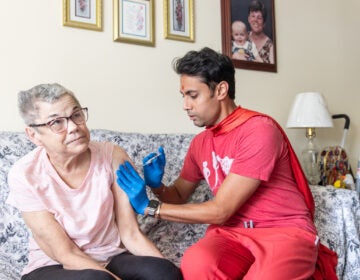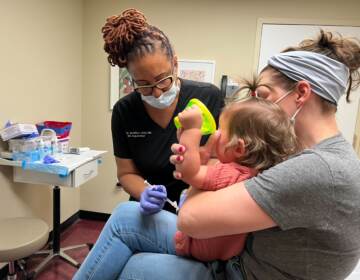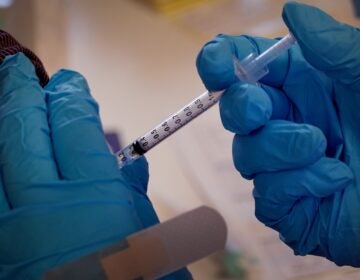Why did gyms have to close for a month in Philadelphia and Pennsylvania?
Owners and gym patrons say safety precautions made restrictions in November and December unnecessary. Others say data suggests a different conclusion.
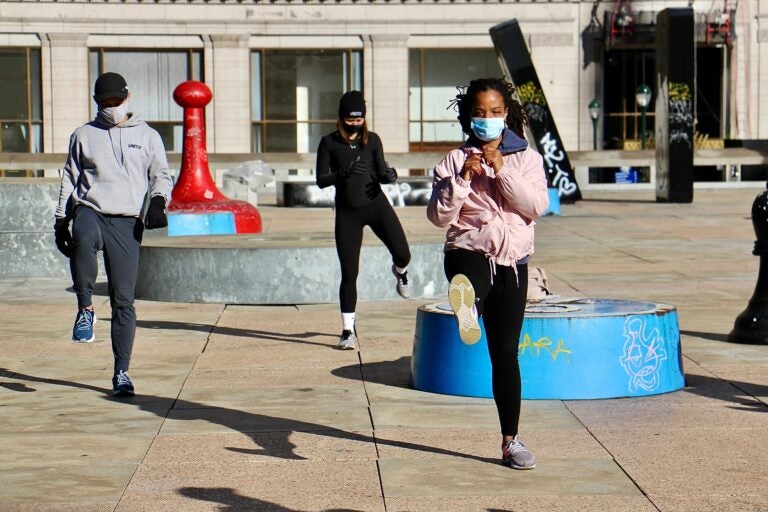
About 25 fitness enthusiasts participate in a protest workout at Thomas Paine Plaza to support gym owners who have been shut down by the coronavirus pandemic on Nov. 24, 2020. (Emma Lee/WHYY)
Ask us about COVID-19: What questions do you have about the current surge?
Starting Monday, gyms in Pennsylvania and Philadelphia can reopen, unless there is a dramatic increase in the number of coronavirus cases.
In November, Philadelphia ordered gyms — along with museums and movie theaters, among other places where people gather indoors — closed to minimize the spread of the virus. The state ordered facilities to close for three weeks starting in mid-December.
Those who own gyms, and people who go to them, wonder why they had to shut down to begin with.
Bill Lane, who lives in Philadelphia, has been back to the gym six days a week since they reopened in the summer, and he finds gyms safer than grocery stores. There were not that many people at the gym, he said, so they could always be far apart from each other.
“All of the gyms, whether you’re on a treadmill or doing anything, they had people going around, making sure you did not remove your mask or lower it below your nose,” Lane said.
Gym owners also were frustrated at having to close late in the year. Gavin McKay, founder of Unite Fitness in Philadelphia, said that gym owners can completely control their environments and that his team would check people’s temperatures, make sure everyone wore masks, disinfect all the equipment, and maintain fresh air flow at all times.
Jaime Sutton, the owner of J’aime Fitness in Philadelphia, said she understood and agreed with the decision to close gyms in March when the city didn’t know as much about the virus. But she had spent money to hire trainers back, buy masks and thermometers, and implement physical distancing measures to reopen safely, only to be told in November that she had to close again.
“We had so many numbers of people coming in our doors since July … even with lower capacity, we had people coming through the doors and we weren’t seeing cases, there was no transmission,” Sutton said. “We would just like to know where officials are getting their information from.”
McKay and Sutton are part of a group called the Philadelphia Fitness Coalition that protested in front of City Hall in November.
James Garrow, director of communications for the Philadelphia Department of Public Health, said the agency applauds any business that opens safely, but that gyms are risky because they are indoor places where people may be close to one another and breathing more heavily than usual.
He added that from mid-July till mid-November, when gyms were open, around 1% of people who tested positive for COVID-19 reported going to a gym where they could have infected other people, and 5% of cases reported going to a gym a week before the onset of symptoms. People can be infectious for around 10 days, according to the Centers for Disease Control and Prevention. Garrow also said the city Health Department has more than 50 documented cases in which people could have been exposed to the virus at a gym.
“This was not just a single gym was the problem, so it becomes difficult for us to say the only gyms that can be open are the ones that are following the rules, without us having to have staff in every gym every minute of the day,” Garrow said. “The Health Department hates having to close down places. But when the choice is keep it open and people potentially end up in hospitals and overwhelm hospitals, that becomes an easy decision to make, and we absolutely regret the damage that this has done to those businesses that have done everything right.”
Earlier this week, the Pennsylvania Department of Health released data that of the 274 people who tested positive for COVID-19 the week of Dec. 13 and said they had been to a business of some kind, 32 said they had gone to a gym, compared to 111 who said they had gone to a restaurant and 20 who said they had gone to a salon or barbershop.
Washington, D.C., maintains a dashboard of where people who tested positive for COVID-19 say they have been in the two weeks leading up to the onset of their symptoms. New York state also released contact tracing data earlier this month showing where people got exposed to COVID-19. In both cases, gyms made the list but were not the largest source of new infections.
Gym owners cite this data to say gyms are far from the most risky place to be. But the answer is more complicated.
Can contact tracing data show where transmission happens? Epidemiologist Emily Gurley, of Johns Hopkins University, said in an interview that the answer is “a very strong maybe.”
Gurley explained that if you want to know whether going to a particular kind of business, like a gym or grocery store, is associated with transmission, you would need to compare people who tested positive for COVID-19 to people who didn’t, and see if those who tested positive were more likely to report to going to the kind of business in question.
“We need some kind of comparison group; that’s how epidemiology works,” she said. “Let’s say you find, and I’ve seen some data to suggest this as well, a lot of people in the two weeks prior to when they got sick went to the grocery store … well, yeah, but most people go to the grocery store, this is an activity of daily living, so how do we know that that’s where people are being infected?”
On the other hand, Gurley said, once contact tracers interview people who tested positive, talk to their contacts, follow up with the ones who tested positive, then you do have data about who exposed them to COVID-19 and where. The other problem being that if there are a lot of cases, as is the case in Philadelphia, contact tracers just cannot talk to all of them.
Garrow, at the Philadelphia Department of Public Health, also cited research published in the journal Nature in November that used anonymized cellphone data from Philadelphia and other large metro areas in the United States from March to May to figure out how people move around and how long people will be in the same place at the same time, to simulate movement patterns and figure out how likely it is that infections could spread in different settings. Those researchers concluded that reopening restaurants, gyms, hotels, and cafes (with no masks or occupancy limits) would produce the largest predicted increase in infections.
Garrow added that the number of cases in Philadelphia has been dropping over the past few weeks, showing the restrictions worked.
As the state and city limits end in early January and gyms can reopen, Gavin McKay of Unite Fitness said it does not mean their troubles are over.
“None of these small businesses are faucets where we can just turn on the revenue and customers and clients and turn it off again. We need to plan, we have staff that have left that are not going to be coming back, we have to hire new people when we’re reopening,” he said. “Our revenue, our clients, our staff, have been on a decline since March … people are backed up against a wall.”

Get daily updates from WHYY News!
WHYY is your source for fact-based, in-depth journalism and information. As a nonprofit organization, we rely on financial support from readers like you. Please give today.

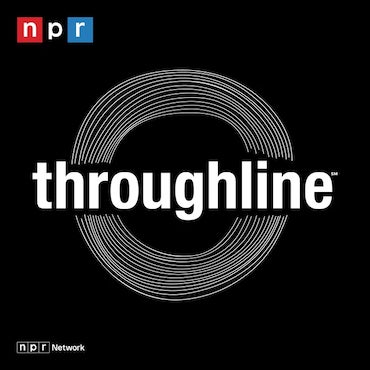

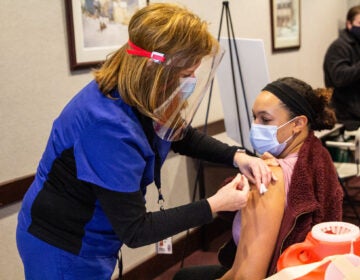
![CoronavirusPandemic_1024x512[1]](https://whyy.org/wp-content/uploads/2020/03/CoronavirusPandemic_1024x5121-300x150.jpg)
